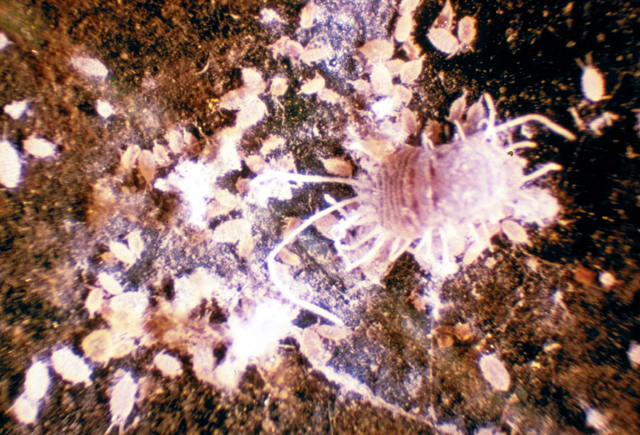Insect And Related Pests of Foliage Plants
Mealybug
Mealybugs
Mealybugs infest a wide range of foliage plants including: Aphelandra, Ardisia, Asparagus ferns, Cryptanthus, Dieffenbachia, Dracaena, False Aralia, Ficus, Gynura, Hoya, Maranta, Nephrolepis and Pothos.
Mealybugs are soft-bodied insects also having piercing-sucking mouthparts and they possess a covering of flocculent, white, waxy threads. A byproduct of mealybug feeding is sticky honeydew which coats infested foliage, as illustrated by the Hoya pictured in this slide and provides an excellent medium for growth of the black sooty mold fungi. This black coating further renders affected plants unsightly. Aphids also produce honeydew and infested plants may also exhibit sooty mold fungi.
Mealybugs, like aphids, are active throughout most of their life. The longtailed, solanum and citrus mealybugs are the species most often detected in greenhouse environments on foliage plants. Infestations are frequently visible on the foliage, as with infestation of this asparagus fern.
However, at times mealybug infestations may occur within the vegetative shoot apex, and may be extremely difficult to detect. This ability of mealybugs to form dense colonies, particularly within the shoot apex, often makes chemical control of this pest quite difficult.
Reproduction under greenhouse conditions is year-round and in certain species by the production of living nymphs or young and often without fertilization. Thus, the escape of a single individual from control efforts may allow the infestation to continue.
Some mealybug species may produce 100-300 eggs enclosed within an egg sac composed of waxy secretions produced by the female. Again, mealybug developmental time is decreased by the high temperatures often encountered in greenhouse environments.
In addition to foliar mealybugs, several small species of mealybugs are found below the soil surface and feed on root and root hairs tissue of numerous tropical foliage plants. Careful examination of infested roots will reveal white, cotton-like masses as illustrated in this slide. These white masses contain both mature females and eggs. Young root mealybugs or nymphs are active and may crawl from pot to pot via drainage holes, or they can be spread in irrigation water.
Infestations of root mealybugs are often overlooked until severe and widespread causing reduced plant growth and foliar yellowing or chlorosis. Infestations frequently are not detected as the pests occur in the soil, and populations are quite slow to develop, with 3-6 months occurring before infestations are easily visible. Infestations often begin with the purchase of infested plant material. Therefore, if possible, samples of newly acquired plants should be removed from their containers and the roots inspected.

Mealybug.
